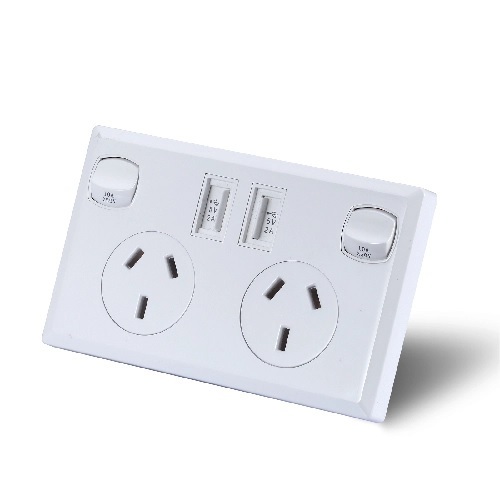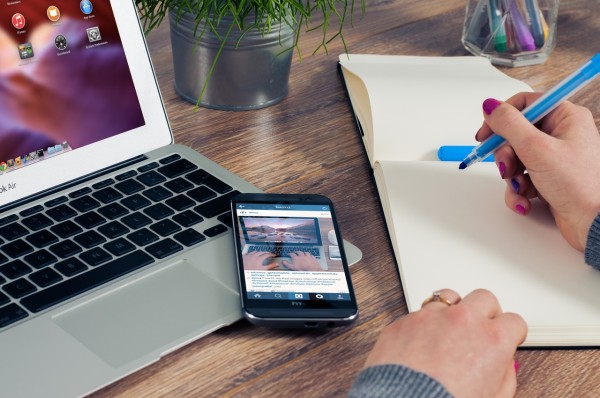With COVID-19 and more and more people working from home, the average Australian home is overwhelmed by electronics and, less pleasantly, all the chargers and cables that come with them.
How can we power and charge our multiple devices on the go without the inconvenience and mess of juggling multiple chargers at once – not to mention avoiding the risk of overloading and requiring electrical maintenance?
Is it time to update our homes’ power points with USB sockets?
To solve this problem, USB wall sockets are becoming increasingly common – in new homes, hotel rooms, planes and cars. They are ideal for the home office, and avoid fights over who gets to use the charger. Most USB Power Points have two regular outlets, and two USB ports, and look like something this:

What is a USB socket?
A USB wall socket is almost identical to a normal power point socket, except for one key difference: in addition to the normal three-prong sockets where we usually plug in our chargers, there are also several (usually two) in-built USB ports. These power points with USB ports mean that our devices no longer need the charger for their power, but can instead be plugged directly into the wall socket.
What are the advantages?
When done by a licensed electrician replacing your power points with USB power points can present a number of benefits in terms of efficiency, convenience and safety considerations.
USB wall chargers supply more current
Many of us charge our smartphones, tablets and other portable devices using either the charger that typically comes with the device, or by plugging the charging cable into a USB port on their computer or laptop.
Generally, wall chargers supply current at a higher voltage than USB ports on our computers. This is because the typical USB port of a desktop computer or laptop usually supply a maximum electrical current of 500 amps at a time. This means the USB wall charger can recharge your phone, tablet or other device in a shorter time period.
More efficient and convenient
Charging your gadgets more quickly and efficiently can be a major time-saver, particularly if like many Sydney households you have multiple users with multiple devices to contend with at any given time.
Unlike with traditional power points, which tend to have only a couple of three-prong receptacles in which to charge our devices, USB wall sockets may mean we no longer have to choose which one of our devices to do without at any given time. In rooms such as offices, living rooms and kitchens, where many electrical devices are often used simultaneously, this can make a big difference.
What’s more, you’ll no longer have to slow down the performance of your computer or laptop by charging your phone through its USB port when you’re also performing energy-intense tasks such as transferring data or watching videos online.
Safety benefits
During our years of helping out with electrical maintenance and repairs all over Sydney, we’ve come across many cases where a single powerpoint is overwhelmed with power boards and adapters. This can lead to overloading, which can be potentially dangerous for your home, even causing fires. Because USB wall sockets can charge devices more efficiently, you’re less likely to need an abundance of power adapters, meaning it carries a lower risk of overloading.
More durable
It’s no secret that phone and tablet chargers are notoriously susceptible to wear and tear – and even, in some cases, becoming out-dated and redundant as we upgrade to later models. Replacing your power point with a USB wall socket can be more durable as you’ll no longer have to rely on these sometimes unreliable chargers, instead plugging your device directly into the wall for charge.
What’s more, it’s likely that USB technology will be here for the long haul and even expand in coming years as the ‘internet of things’ in everyday objects becomes increasingly common.
Are there any disadvantages?
The main disadvantage of having USB wall sockets in our homes is the upfront cost of replacing your current powerpoints with the newer, sleeker alternative. They’re also not recommended for those whose smartphones, tablets or other devices don’t use a standardised USB port.
How to install a USB socket in your home
As far as DIY projects go, installing a USB socket or outlet in your home yourself is an option for those with sound electrical knowledge and tools, but it can be fiddly work and you would need to at least know how to wire a wall plate. Do be wary when buying electronics, including power points, online as many of these products sold on international websites fall short of Australian safety standards.
Hiring a licensed electrician to take care of the job for you is a safer bet. Getting the experts on board is safer, less of a hassle and can be more cost-effective in the long run, particularly when it comes with a 100% guarantee for any repairs like we offer here at Electric Express.
If you’d like to have a USB socket installed in a power point in your home, or would like to talk through other modern tech options, contact our team of experienced electricians today, or call us on 0411 188 492.

